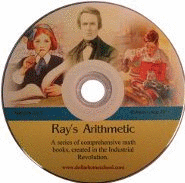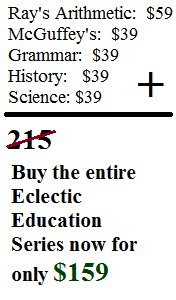|
Dollar
Homeschool Bringing Back American Education |
|
|
||||
Ray's
Arithmetic Part of the Eclectic Education
Series
Part of the Eclectic Education
Series |
There are 38 books, if you include Answer Keys/Teachers Editions. The Teachers Editions are simply the same book as their counterpart, with the answers included next to most of the problems. If you would like to see sample pages from the books, those can be viewed by clicking here. Basic Math “An effort has been made throughout the work to observe a natural and strictly logical connection between the different parts, so that the learner may not be required to rely on a principle, or employ a process, with the rationale of which he is not already acquainted”
Ray's Practical Arithmetic. 337 pages. Practical Arithmetic starts by quickly reviewing the basics of addition, subtraction, multiplication and division covered previously in Elementary Arithmetic, and then moves into a study of different types of measurement, followed by factoring, and a more involved study of fractions and percentages. After these mathematical bases have been studied and mastered, real world applications for these mathematics are introduced. These include Transactions, Commissions, Stock values and investments, Interest, Discounts, Monetary exchange, Insurance and Taxes. Practical Arithmetic then concludes by introducing basic geometry. Intermediate Math ”To fix the principles in the mind of the student, and to show their bearing and utility, great attention has been paid to the preparation of practical exercises.” This continual grounding in practicality is a peculiar aspect of
Ray's Arithmetic, one which is very rare and very valuable. Modern math books have focused so much on the
abstract that the student is left to wonder how he will ever be able to use it in his day to day life; a feeling
that easily makes mathematics seem like a chore or useless exercise.
Ray's New Elementary Algebra. 241 pages. “In introducing Algebra to the student with Elementary Algebra, great care has been taken to make the student feel that he is not operating with unmeaning symbols, by means of arbitrary rules; that Algebra is both a rational and practical subject, and that he can rely on his reasoning, and the results of his operations with the same confidence as in arithmetic. For this purpose, he is furnished, at almost every step, with the means of testing the accuracy of the principles on which the rules are founded, and of the results which they produce.” I cannot stress highly enough the importance the above paragraph has to a student embarking on a study of Algebra. From personal experience while studying with Saxon Algebra I know just how frustrating it is to be told what to do, while not given any reasons for why we are doing it or how it works. I didn't want to simply take their word for it but prove it for myself, a thought process most students share. And while I did manage to work these things out eventually, it was a slow and painful process. One of the things that make Ray's Arithmetic such an excellent series is the attention given to the student. Instead of neglecting the reasoning and deducing ability of the students themselves, they are instead encouraged to think on their own. This increases the students interest, his understanding of the material, as well as his recollection of studies later on. Ray's New Elementary Algebra focuses on the basic forms of Algebra.
Algebraic Fractions, Simple Equations, Powers, Roots, Radicals, and finally Quadratic Equations are among the
concepts explored. As always, after a concept has been taught, real-world applications for the process are given
to the student.
Ray's New Higher Algebra. 407 pages. After reviewing the fundamentals, Higher Algebra then moves on to Theorems, Factoring, Algebraic Fractions, Quadratic Equations, Ratio, Proportion, Binomial Theorem, etc etc. This book is quite lengthy, thoroughly teaching algebraic concepts. While there are relatively few problems for the student to work on and solve, these have been supplied by Test Problems for Ray's New Higher Algebra. 152 pages, as well as A Complete Algebra. 359 pages.
Advanced Math Ray's Treatise on Geometry and Trigonometry. 421 pages. Begins by giving definitions for some basic geometrical terms, then begins Geometry, starting with parallel lines, then continuing with Arcs and Radii, the properties of triangles, Parallelograms, measuring area, Polygons, the geometry of space, Pyramids, Prisms, etc. The book then continues on into the subject of Trigonometry, and supplies logarithmic tables. No problems are supplied for the student in this book, which instead gives all it's attention to teaching the concepts. It is suggested that the student use another book to provide problems while learning the mathematical processes from this book.
Ray's Differential and Integral Calculus. 442 pages. Begins with definitions. Careful attention has been given to the teaching of the doctrine of limits, which has been made the basis of both the Differential and Integral Calculus. Problems are supplied in the book.
Extra-Curricular Texts
In order to provide students with examples of the interesting
fields mathematical studies opens, several books of ranging difficulties have been supplied. Complete Book Keeping. 161 pages. An often
over-looked area of study, book-keeping will always be an important area of expertise for anyone who earns or
spends money. As the author states: “Book-keeping... cultivates the judicial powers of the mind... contributes
to private and public virtue.. leads to economy and thrift... and it's practice will reduce pauperism and
crime.” Beginning with the basic form of double entry book-keeping, Debit, Credit, and all areas of accounting
are taught. Norton's Elements of Physics. 269 pages. This
incredibly well-written and intriguing book is so well written that it does not feel so much like a dry text on
the mathematics of physics as an exploration of physical laws, thus allowing someone well acquainted with
physics or not at all to read this book with great enjoyment. Carefully illustrated, this book begins by
introducing the student first to general notions of matter and force, and then introducing new elements one by
one. Friction, adhesion, fluids, sound, light, heat, and electricity are all explored, with careful explanations
of experiments and studies done by the scientists who explored these properties. Schuyler's Principles of Logic. 169 pages. Logic
is a mathematical pursuit. How can we tell? Through logic.... Because math is based on logical premises
(induction), and then followed through in a logical working out of the premises (deduction). The author explains
this more thoroughly, but you'll have to read the book. Ray's Elements of Astronomy. 342 pages. Taking a
different approach to astronomy, rather than focusing on the Greek names for constellations this book focuses on
the movements of heavenly bodies and the science of astronomy.
Ray's Surveying and Navigation. 492 pages. While this book thoroughly covers the old art of Surveying (the same business George Washington was in for a number of years) this book is especially useful because of it's great attention to the field of Plane and Spherical Trigonometry and Mensuration, and may because of this be used as a textbook for those fields.
|
 |
|
|
|
|
|
|
|
|
|
|
|
|
|
|
|
 |
|||||||
|
|||||||
|
|||||||
|
|||||||
© Copyright Dollar Homeschool, 2008. All
Rights Reserved.














